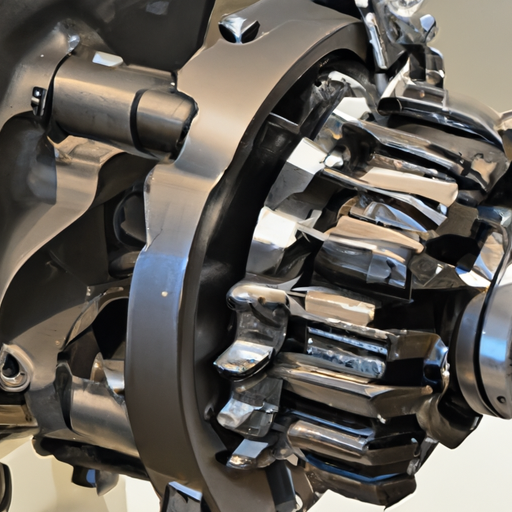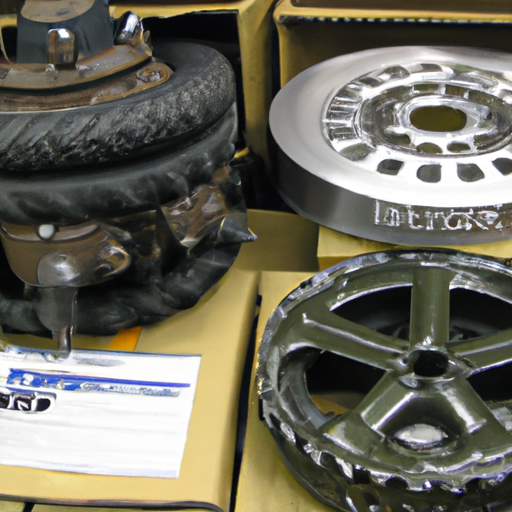Looking to upgrade your vehicle’s axle? Look no further, because in this article, we’re going to compare the Ford 8.8 and the Dana 44 axles. Both known for their durability and strength, these two axles have been popular choices among off-road enthusiasts and gearheads alike. So, if you’re wondering which one is the better option for your vehicle, stick around and let’s dive into the Ford 8.8 vs. Dana 44 showdown.
Overview
When it comes to upgrading the axle in your vehicle, two popular options that often come up in discussions are the Ford 8.8 and the Dana 44. These axles are renowned for their strength and durability, making them ideal candidates for off-road adventures or applications that require heavy-duty performance. In this article, we will explore the design, construction, size, weight, axle shafts, differentials, brakes, aftermarket support, off-road performance, and on-road performance of both the Ford 8.8 and Dana 44 axles. By the end, you’ll have a comprehensive understanding of each axle’s features and be able to determine which one is best suited for your needs.
What are Ford 8.8 and Dana 44?
The Ford 8.8 and Dana 44 are both solid rear axles commonly found in a variety of vehicles. The Ford 8.8 axle is manufactured by Ford Motor Company and is known for its strength and reliability. It has been used in various Ford vehicles, including the Ford Ranger, Ford Bronco, and Ford Explorer. On the other hand, the Dana 44 axle is produced by Dana Incorporated and is widely regarded as one of the best axles for off-road enthusiasts. It has been used in a wide range of vehicles, including Jeep Wranglers, Dodge Ram trucks, and Ford F-150s.
Applications
Both the Ford 8.8 and Dana 44 axles have a wide range of applications. Due to their durability and strength, they are often used in off-road vehicles and trucks that require heavy-duty performance. The Ford 8.8 axle, with its robust design and high torque capacity, is particularly popular among Ford enthusiasts looking to upgrade their axles for improved off-road capabilities. The Dana 44, with its reputation for reliability and superior ground clearance, is a favorite among Jeep and truck owners who want to conquer challenging terrains and trails.

Strength and Durability
When it comes to strength and durability, both the Ford 8.8 and Dana 44 axles excel. The Ford 8.8 axle is known for its robust design and ability to handle high torque demands. Its large ring gear diameter and thick axle tubes contribute to its strength, making it a reliable choice for off-roading or towing heavy loads. Similarly, the Dana 44 axle is hailed for its durability and ability to withstand intense off-road conditions. Its heavy-duty construction, reinforced housing, and larger ring gear make it a formidable axle that can withstand the rigors of off-roading.
Compatibility with Vehicles
One of the key factors to consider when choosing between the Ford 8.8 and Dana 44 axles is their compatibility with different vehicles. The Ford 8.8 axle is primarily found in Ford vehicles, including the Ford Ranger, Ford Bronco, and Ford Explorer. This means that if you own a Ford vehicle, finding a compatible Ford 8.8 axle shouldn’t be an issue. On the other hand, the Dana 44 axle is found in a wider range of vehicles, including Jeep Wranglers, Dodge Ram trucks, and Ford F-150s. This makes the Dana 44 axle a more versatile option if you own a vehicle from a different manufacturer.

Design and Construction
Ford 8.8 Design
The Ford 8.8 axle is renowned for its robust design and high torque capacity. It features a large ring gear diameter, typically around 8.8 inches, which contributes to its strength and durability. The axle tubes on the Ford 8.8 are thick and made from high-strength steel, further enhancing its ability to withstand heavy loads and off-road abuse. Additionally, the Ford 8.8 axle is available in both semi-float and full-float configurations, providing options for different applications and load capacities.
Dana 44 Design
The Dana 44 axle is known for its time-tested design and rugged construction. It features a larger ring gear diameter compared to the Ford 8.8, typically ranging from 8.5 to 8.8 inches, which enhances its strength and torque capacity. The Dana 44 axle utilizes a reinforced housing and thicker axle tubes, providing additional strength and durability. This axle is available in both semi-float and full-float configurations, making it suitable for a wide range of applications.
Gear Ratio Options
Both the Ford 8.8 and Dana 44 axles offer a variety of gear ratio options to choose from. The gear ratio determines the number of revolutions the driveshaft makes for one complete rotation of the axle, and it plays a crucial role in the vehicle’s performance and capabilities. Whether you’re looking for better acceleration or improved fuel efficiency, there’s likely a gear ratio option available for your specific needs. It’s important to note that gear ratio options may vary depending on the specific vehicle and axle configuration.
Size and Weight
Dimensions of Ford 8.8
The Ford 8.8 axle boasts compact overall dimensions, making it suitable for a wide range of vehicle applications. The exact dimensions may vary slightly depending on the specific model and configuration, but typically, the Ford 8.8 axle measures around 60 inches in width. It’s important to consider these measurements when determining if the Ford 8.8 axle will fit within the wheel wells of your vehicle without any clearance issues.
Dimensions of Dana 44
The Dana 44 axle is slightly larger in size compared to the Ford 8.8. The exact dimensions may vary depending on the specific model and configuration, but typically, the Dana 44 axle measures around 63 inches in width. While the larger size provides enhanced ground clearance and stability, it’s crucial to ensure that the Dana 44 axle will fit within the wheel wells of your vehicle without causing any rubbing or clearance issues.
Weight Comparison
When it comes to weight, there is a notable difference between the Ford 8.8 and Dana 44 axles. The Ford 8.8 axle is generally lighter compared to the Dana 44, which can be attributed to its smaller size and construction materials. The weight difference may not be significant enough to impact the overall performance or handling of your vehicle, but it’s important to consider if you have any weight restrictions or if you’re looking to minimize the additional weight added by the axle upgrade.

Axle Shafts
Ford 8.8 Axle Shafts
The axle shafts used in the Ford 8.8 axle are known for their strength and durability. These shafts are typically made from high-grade alloy steel and undergo heat treatment to ensure maximum strength and resistance to bending or breaking. The Ford 8.8 axle shafts also feature larger spline counts compared to some other axles, allowing them to transmit more torque and handle higher loads without failure. Overall, the axle shafts of the Ford 8.8 contribute to its reputation for durability and reliability.
Dana 44 Axle Shafts
The Dana 44 axle shafts are also designed to withstand the demands of off-road adventures. These shafts are made from high-strength alloy steel and undergo various heat treatments and machining processes to optimize their strength and durability. The spline count on the Dana 44 axle shafts is typically larger than average, enabling them to transmit higher torque and handle heavy loads. Whether you’re tackling rocky terrains or crawling over obstacles, the Dana 44 axle shafts provide the necessary strength and confidence.
Strength Comparison
When it comes to the strength of the axle shafts, both the Ford 8.8 and Dana 44 hold their ground. While specific strength ratings may vary depending on the specific model and configuration, both axles are engineered to handle the demands of off-road use and heavy loads. The larger spline count and high-grade alloy steel used in the construction of both axle shafts contribute to their ability to withstand torque and resist bending or breaking. Ultimately, the strength of the axle shafts in either axle should meet the requirements of most off-road applications.
Differential
Ford 8.8 Differential
The differential is a critical component of any axle, as it allows the wheels to rotate at different speeds during turns. The Ford 8.8 axle is equipped with a versatile range of differential options that cater to different performance needs. The most common differential types found in the Ford 8.8 axle include the open differential, limited-slip differential, and electronic locking differential. The open differential provides equal power distribution to both wheels, while the limited-slip differential transfers power to the wheel with better traction. The electronic locking differential allows the driver to manually lock both wheels together, providing maximum traction in challenging off-road situations.
Dana 44 Differential
Similar to the Ford 8.8, the Dana 44 axle offers various differential options to suit different performance requirements. The most common differential types found in the Dana 44 axle include the open differential, limited-slip differential, and electronically controlled limited-slip differential. These differentials operate in a similar manner to the Ford 8.8 options, providing enhanced traction and performance based on the specific needs of the driver and vehicle.
Options and Performance
Both the Ford 8.8 and Dana 44 axles provide a range of differential options that cater to different performance needs. The choice of differential is crucial as it directly impacts the vehicle’s handling, traction, and overall performance. The open differential, which is the most common option, provides equal power distribution to both wheels, making it suitable for daily driving or mild off-road use. The limited-slip differential transfers power to the wheel with better traction, minimizing wheel slippage and improving traction in challenging terrain. The electronically controlled locking differentials in both axles allow the driver to manually lock both wheels together, providing maximum traction in extreme off-road situations.

Brakes
Ford 8.8 Brakes
When it comes to brakes, the Ford 8.8 axle offers a variety of options to choose from. The brake configurations can vary depending on the specific model and vehicle application, but typically, the Ford 8.8 axle can be equipped with either drum brakes or disc brakes. Disc brakes are generally preferred as they offer better stopping power, improved heat dissipation, and easier maintenance compared to drum brakes. However, some older models or budget-friendly configurations may still feature drum brakes.
Dana 44 Brakes
Similarly, the Dana 44 axle can be outfitted with different brake options, including both drum brakes and disc brakes. As with the Ford 8.8 axle, disc brakes are generally the preferred choice for their superior stopping power and heat dissipation capabilities. Disc brakes offer improved braking performance, particularly when traversing steep downhill terrains or when carrying heavier loads. However, it’s important to consult the specific vehicle’s configuration and brake options to ensure compatibility with the Dana 44 axle.
Stopping Power
When it comes to brake performance, both the Ford 8.8 and Dana 44 axles can provide ample stopping power, depending on the brake configuration chosen. Disc brakes, being the preferred option, offer superior stopping power due to their design and enhanced heat dissipation capabilities. They can provide consistent braking performance even under demanding conditions, such as extended downhill descents or heavy towing. On the other hand, drum brakes, while previously more common, may not offer the same level of stopping power as disc brakes but can still provide satisfactory performance for typical on-road driving. It’s crucial to consider your specific needs and preferences when choosing the brake configuration for your chosen axle.
Aftermarket Support
Availability of Parts and Upgrades
When it comes to aftermarket support, both the Ford 8.8 and Dana 44 axles have a robust ecosystem of parts and upgrades available. Due to their popularity and widespread use, a wide range of manufacturers produce various components specifically designed for these axles. From differential lockers and axle shafts to upgraded gear sets and performance brakes, there are numerous options to help you customize, upgrade, or repair your axle. This allows you to tailor your axle to your specific needs and preferences, whether you’re looking to enhance off-road performance or maximize towing capabilities.
Cost Comparison
In terms of cost, both the Ford 8.8 and Dana 44 axles can vary depending on factors such as the specific model, vehicle application, and the desired features or upgrades. Generally, the Ford 8.8 axle is considered to be more cost-effective compared to the Dana 44 axle. This is primarily due to the wider availability of Ford 8.8 axles in salvage yards and the lower demand for certain configurations. However, it’s crucial to consider the overall cost of the axle upgrade, including any necessary modifications, labor, and additional components required for the installation.
Ease of Modification
Both the Ford 8.8 and Dana 44 axles are relatively straightforward to modify, making them popular choices for enthusiasts who enjoy customizing their vehicles. The availability of aftermarket parts and upgrades specifically designed for these axles simplifies the modification process. Whether you’re looking to change the gear ratio, upgrade the differential, or install performance brakes, there are comprehensive guides, resources, and even preassembled axle kits available to assist you in the modification process. However, it’s important to have a good understanding of your vehicle’s specific requirements and consult experienced professionals if you’re unsure about any modifications.

Off-Road Performance
Traction and Grip
When it comes to off-road performance, both the Ford 8.8 and Dana 44 axles offer impressive traction and grip. The robust construction, strength, and differential options available for both axles contribute to their ability to tackle challenging terrains and provide ample traction. However, it’s worth noting that the specific off-road performance can be influenced by various factors, such as the vehicle’s weight distribution, suspension setup, tire choice, and overall vehicle configuration. These factors need to be taken into account when evaluating the off-road performance of the axle in your specific vehicle.
Ground Clearance
Ground clearance is a crucial aspect of off-road performance, as it determines the ability of your vehicle to navigate over obstacles and rough terrains without getting stuck or damaged. Both the Ford 8.8 and Dana 44 axles offer respectable ground clearance, but there are some differences to consider. The Dana 44 axle, with its slightly larger size compared to the Ford 8.8, generally provides a slightly higher ground clearance. This can be advantageous when tackling large rocks, steep inclines, or deep ruts, offering a better approach, departure, and breakover angles. However, it’s important to remember that ground clearance is also influenced by other vehicle-specific factors, such as suspension lift, tire size, and overall vehicle height.
Upgrade Options
When it comes to upgrading the off-road performance of your axle, both the Ford 8.8 and Dana 44 offer numerous options. From locker differentials and upgraded axle shafts to heavy-duty covers and reinforced housings, there are a plethora of aftermarket upgrades available to enhance the off-road capabilities of these axles. Whether you’re looking to conquer extreme terrains, improve traction on challenging surfaces, or increase the load-carrying capacity of your vehicle, there is an upgrade available to suit your needs.
On-Road Performance
Smoothness and Comfort
While off-road performance is important, on-road performance is equally crucial for everyday driving comfort and enjoyment. Both the Ford 8.8 and Dana 44 axles can provide a smooth and comfortable ride on the road. The robust construction and design of these axles contribute to their ability to handle the demands of on-road driving, ensuring a stable and predictable experience. However, it’s important to note that additional modifications, such as suspension upgrades or specialized shock absorbers, might be necessary to further enhance the on-road performance and comfort of your vehicle.
Noise and Vibration
While the Ford 8.8 and Dana 44 axles are designed to minimize noise and vibration, there can be some variations depending on the specific axle configuration and vehicle setup. It’s important to consider the overall drivetrain system, including the transfer case, driveshafts, and tires, as these components can contribute to noise and vibration issues. Proper installation, use of quality components, and regular maintenance can help minimize any potential noise or vibration, ensuring a smoother and more comfortable driving experience.
Handling and Stability
Both the Ford 8.8 and Dana 44 axles can provide excellent handling and stability on the road. The robust construction, reinforced housings, and well-designed differential options ensure predictable handling characteristics and better overall stability. When properly installed and integrated with the vehicle’s suspension system, these axles can significantly improve the vehicle’s handling and responsiveness, even during high-speed maneuvers or quick lane changes. However, it’s worth noting that handling and stability can also vary depending on other vehicle-specific factors, such as tire choice, suspension setup, and overall vehicle weight distribution.
Conclusion
When it comes to upgrading your vehicle’s axle, both the Ford 8.8 and Dana 44 axles offer impressive features and capabilities. The Ford 8.8 axle, known for its robust design, versatility, and affordability, is an excellent choice for Ford vehicle owners looking to enhance their off-road capabilities. On the other hand, the Dana 44 axle, revered for its strength, durability, and widespread compatibility, is a popular choice among Jeep and truck enthusiasts seeking unparalleled off-road performance. Ultimately, the suitability of each axle depends on your specific needs, vehicle configuration, and personal preferences.
Suitability for Different Applications
The Ford 8.8 axle is well-suited for Ford vehicle owners who want to upgrade their axle for improved off-road capabilities. Its robust design, high torque capacity, and wide availability of parts make it a reliable choice for a range of applications.
The Dana 44 axle, with its strength, durability, and versatile compatibility with various vehicles, is an ideal choice for Jeep and truck owners who require exceptional off-road performance and reliability.
Personal Preference
Choosing between the Ford 8.8 and Dana 44 axles ultimately comes down to personal preference. Factors such as brand loyalty, vehicle compatibility, available aftermarket support, and desired off-road capabilities can heavily influence your decision.
Final Verdict
In conclusion, both the Ford 8.8 and Dana 44 axles offer impressive features and capabilities, making them reliable choices for upgrading your vehicle’s axle. With their strength, durability, and aftermarket support, these axles can significantly enhance your off-road performance, handling, and reliability. Remember to consider your specific needs, vehicle compatibility, and personal preferences when making your decision. Ultimately, the best axle for you will depend on your unique requirements and the specific demands of your vehicle.
